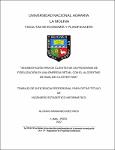Mostrar el registro sencillo del ítem
Segmentación RFM de clientes de un programa de fidelización en una empresa retail con el algoritmo de análisis clúster PAM
| dc.contributor.advisor | Soto Rodríguez, Ivan Dennys | |
| dc.contributor.author | Diez Rios, Alonso Armando | |
| dc.date.accessioned | 2023-03-17T19:57:49Z | |
| dc.date.available | 2023-03-17T19:57:49Z | |
| dc.date.issued | 2022 | |
| dc.identifier.uri | https://hdl.handle.net/20.500.12996/5705 | |
| dc.description | Universidad Nacional Agraria La Molina. Facultad de Economía y Planificación. Departamento Académico de Estadística e Informática | es_PE |
| dc.description.abstract | Las empresas enfrentan el desafío de manejar gran cantidad de datos, aprovecharlos y transformarlos en información valiosa que generen insights relevantes para toma de decisiones y alinear la estrategia. Una de las técnicas más utilizadas ha sido el análisis de agrupamiento en biología, ingeniería, psicología, y otras disciplinas, pero donde habría resultado de mayor utilidad es en los negocios, específicamente en investigación de mercados, desde la segmentación de clientes, identificación de hábitos de compra y otros. Así, la empresa de retail de la que se trata en este trabajo, opera bajo un enfoque centrado en el cliente, por lo cual busca mayor entendimiento del mismo, aprovechando los datos que dispone. El área de Inteligencia de Negocios es responsable del tratamiento y análisis de datos, proponiendo una segmentación RFM con un análisis clúster, que permitió agrupar a un conjunto de clientes objetivo para la empresa, para entenderlos mejor y sirvió como insumo para el programa de fidelización que la empresa lanzó. El algoritmo aplicado para el agrupamiento fue el PAM, que consiste en un proceso de partición iterativo similar al algoritmo k-means, pero que utiliza como centroide la mediana y no la media, haciendo al PAM más robusto ante valores atípicos. El algoritmo se basa en minimizar la suma de las diferencias entre una observación y la mediana. El análisis y procesamiento de datos se realizó con el software R-Studio, y se obtuvieron 3 grupos que describen como se comportan transaccionalmente los clientes objetivo de la empresa. Los segmentos fueron denominados Vip (clientes Top), Plus (clientes intermedio) y Regular (de menor rendimiento), ordenados jerárquicamente. Estos segmentos le sirvieron a la empresa para entender el comportamiento de estos clientes, sentando las bases para el programa de fidelización. | es_PE |
| dc.description.abstract | Companies face the challenge of managing a large amount of data, taking advantage of it and transforming it into valuable information that generates relevant insights for decision making and aligning the strategy. One of the most used techniques has been cluster analysis in biology, engineering, psychology, and other disciplines, but where it would have been most useful is in business, specifically in market research, from customer segmentation, identification of habits shopping and others. Thus, the retail company discussed in this work operates under a customer-centric approach, which is why it seeks a better understanding of it, taking advantage of the data it has. The Business Intelligence area is responsible for the treatment and analysis of data, proposing an RFM segmentation with a cluster analysis, which allowed grouping a set of target customers for the company, to understand them better and served as input for the loyalty program that the company launched. The algorithm applied for the grouping was the PAM, which consists of an iterative partitioning process similar to the k-means algorithm, but which uses the median and not the mean as the centroid, making the PAM more robust against outliers. The algorithm is based on minimizing the sum of the differences between an observation and the median. The analysis and processing of data was carried out with the R-Studio software, and 3 groups were obtained that describe how the target customers of the company behave transactionally. The segments were called Vip (Top customers), Plus (intermediate customers) and Regular (lowest performance), arranged hierarchically. These segments helped the company to understand the behavior of these customers, laying the foundations for the loyalty program. | en_US |
| dc.format | application/pdf | en_US |
| dc.language.iso | spa | es_PE |
| dc.publisher | Universidad Nacional Agraria La Molina | es_PE |
| dc.rights | info:eu-repo/semantics/openAccess | en_US |
| dc.rights.uri | https://creativecommons.org/licenses/by-nc-nd/4.0/ | * |
| dc.subject | programa de fidelización | es_PE |
| dc.title | Segmentación RFM de clientes de un programa de fidelización en una empresa retail con el algoritmo de análisis clúster PAM | es_PE |
| dc.type | info:eu-repo/semantics/bachelorThesis | en_US |
| thesis.degree.discipline | Estadística e Informática | es_PE |
| thesis.degree.grantor | Universidad Nacional Agraria La Molina. Facultad de Economía y Planificación | es_PE |
| thesis.degree.name | Ingeniero Estadístico Informático | es_PE |
| dc.subject.ocde | https://purl.org/pe-repo/ocde/ford#4.05.00 | es_PE |
| renati.author.dni | 48505354 | es_PE |
| dc.publisher.country | PE | es_PE |
| dc.type.version | info:eu-repo/semantics/publishedVersion | en_US |
| renati.advisor.orcid | https://orcid.org/0000-0002-4928-8362 | es_PE |
| renati.advisor.dni | 07029635 | es_PE |
| renati.type | https://purl.org/pe-repo/renati/type#trabajoDeSuficienciaProfesional | es_PE |
| renati.level | https://purl.org/pe-repo/renati/level#tituloProfesional | es_PE |
| renati.discipline | 542026 | es_PE |
| renati.juror | Menacho Chiok, Cesar Higinio | |
| renati.juror | Febres Huamán, Grimaldo José | |
| renati.juror | Salazar Vega, Rolando Jesús |
Ficheros en el ítem
Este ítem aparece en la(s) siguiente(s) colección(ones)
-
EPL-EI Tesis [78]





